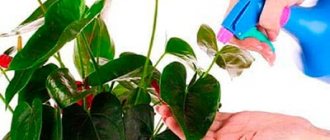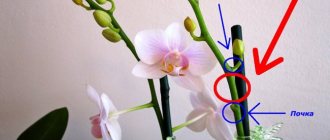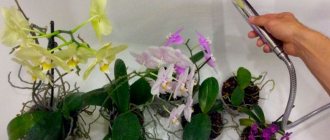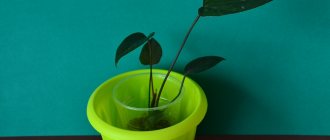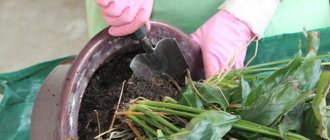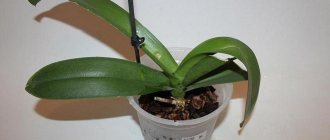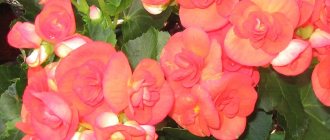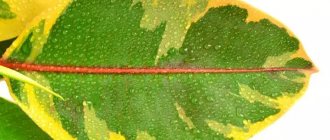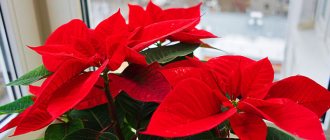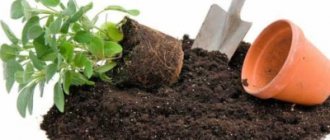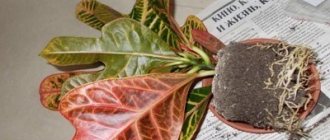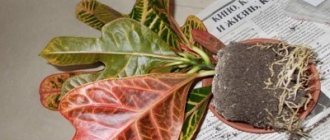The anthurium plant comes from the humid tropics, a flower in the form of an elongated graceful cob, surrounded by a modified shiny leaf. It comes in various shapes and colors - white, pink, red. There are several hundred varieties of anthuriums in the world. More often you can find 3 of them in houses. All varieties are sensitive to air and soil humidity. This is due to their origin.
Anthurium is popularly known as “Male Happiness”. The version of the origin of the unusual name is that the flower of the plant is similar in shape to the emblem of love - a heart that is pierced by an arrow. How to determine when it is time to water a plant? This can be done based on the condition of the soil in which the plant grows.
If the flower has already reached the age of 3-5 years, then irrigation can be carried out when the soil has already dried a couple of centimeters. If the anthurium is still young, then you should not let the soil dry out. It should always remain slightly damp.
Anthurium, or male happiness - description of the flower
Evergreen beautifully flowering, less often decorative-deciduous anthurium (anthurium) represents the Araceae (Aronnikov) family. According to various data, species diversity ranges from 500 to a thousand species, most of them are epiphytes. Plants in their natural environment are common in the humid tropics and subtropics, and therefore love warmth and moisture. The shape and size of the leaves of a flower are determined by the species; they can be whole or dissected, large or small, with veins that stand out in color or with a unique ornament.
The spadix-shaped flowers are equipped with a bract, often a large leaf, which makes the plant especially attractive. The color of the bract in different species varies from various shades of white to rich red, purple, yellow, and can be monochromatic, transitional, or variegated.
Anthurium owes its second name - male happiness - to the cob-shaped inflorescence, in which they once saw a phallic symbol. The plant is also often called a tail flower, flamingo, artist’s palette, and even a pig’s tail or devil’s finger.
Folk signs and beliefs associated with anthurium
Anthurium. What does this flower mean? The flower is literally shrouded in mystical beliefs. In the tropics, where it originated, it was customary to give it to newlyweds as a wedding gift. It was believed that it harmonizes the situation in the house, pacifies conflicts, and increases well-being.
Unusual properties of anthurium
It is equally useful for both men and women. It is no coincidence that it is called either “Male Flower” or “Women’s Happiness”. Moreover, neither the age nor the color of the plant play a special role.
Anthurium tricolor
The plant helps a man gain self-confidence; the flower, like a magnifying glass, allows him to see the best sides of both partners, stimulating a trusting relationship. It’s called Anthurium – “Men’s Happiness”. By the appearance of the plant, you can determine how beneficial the environment in the house is. The flower helps overcome stress and cope with nervous tension.
Anthurium in the greenhouse
A flowering plant is the best indicator of a happy and healthy relationship. This flower is one of the few that is customary to give to men. A large number of magicians use the plant as a kind of financial magnet. The color of the plant does not matter; the better it blooms, the more stable the financial situation in the family.
Blue anthurium
How to properly water anthurium at home, step by step photo
Experienced gardeners have developed a system of rules for watering indoor flamingo flowers. The “Code of Laws” determines the time of watering, its frequency, water requirements and other subtleties important for the quality development and flowering of the plant.
On a note! To prevent the anthurium from being damaged when the owner leaves for 10-15 days, spacer sticks are inserted into the pot, the soil is moderately moistened, placed in a transparent plastic bag and tied loosely.
How to determine that anthurium requires watering
An attentive florist quickly learns to detect a lack of moisture; the flower does not hide its dissatisfaction:
- the rich color of the bract fades, as if molting;
- the leaves lose their elasticity and shine and droop.
Note! “Male happiness” reacts sharply to the lack of moisture not only in the soil, but also in the air. This is especially important for young plants; they not only artificially maintain high humidity, but do not allow the soil in the pot to dry out.
Some gardeners weigh the pots to determine the need for watering: a dry substrate is much lighter than a saturated one. Instead of hassling with scales, you can pay attention to the angle of inclination of the leaves: if it is less than 45°, it’s time to water.
How often, what kind of water to water the flower and how much it should be taken
The flamingo flower is very sensitive to water quality. To avoid problems with his health, comply with the following requirements:
- soften hard water with 1-2 drops of lemon juice;
- water temperature – not lower than room temperature;
- Tap water must be allowed to stand for 3-4 days.
The ideal water for watering “male happiness” is rain or melt water; if possible, this is what is used. Experienced flower growers advise flavoring the water with several crystals of potassium permanganate every six months to prevent possible diseases.
The amount of water added to the flower and the frequency of watering are directly related to the following factors:
- Pot material. It is known that clay containers that are not covered with glaze not only absorb water, but also actively evaporate it. Flowers growing in such “apartments” need more water.
- Age of the tail flower. Adult specimens are watered when the soil dries out a little. Young ones need moisture more, so water them more often.
- Stage of development. The active growth and flowering phase requires more water than the dormant period.
The frequency of watering is affected by the temperature and humidity in the room, and the level of light. A well-lit plant located in a warm room is watered more often than one growing in a cool room with a lack of light.
Know! It happens that the substrate for growing anthurium turns out to be dense and heavy. In this case, before transplanting, the frequency of watering and its volume are reduced by a third.
You need to water the anthurium in the morning, this way it is easier to avoid stagnation of water.
What kind of water is needed for irrigation?
Anthurium is very picky about the physical characteristics of water. You cannot water it with cold water. Water just over 20-21°C is suitable.
Water with a high level of hardness is prohibited for the plant. Do not water the anthurium with tap water. This will negatively affect its decorativeness and immunity. Tap water is left to settle for 3-5 days or melted rain water is used.
Watering the plant depending on the type
A. climbing plant, which does not have a dormant period, is watered evenly all year round. In addition, it benefits from regular spraying of leaf blades, stems, and aerial roots.
A. Scherzer needs to reduce watering and stop spraying in winter.
A. Crystal is watered the same way at any time of the year.
A. Andre during growth requires regular, abundant watering, which is reduced in winter. Every day, the leaves of representatives of this species are sprinkled with water.
A. Linden is watered only through a tray; it is a very rare flower for home cultivation, and such watering is an additional precaution so as not to lose the exotic.
A. Hooker, a rare, although more hardy flower, in the active growth phase is watered often and abundantly, but not allowing stagnation of water. In a state of forced dormancy, the frequency and volume of watering is reduced.
A. Wendlinger is watered according to a standard scheme, all parts of the plant, except flowers, are sprayed 1-2 times a day in summer, in winter - every 2-3 days.
A. Veitch is watered in summer according to standard rules for anthuriums, in winter - very moderately. In addition, during the warm season, the leaves are sprayed with water daily; in winter, the procedure is carried out every other day.
Important! A thick layer of drainage will protect “male happiness” from stagnation of excess moisture.
Spraying
Since the plant is a native of tropical rainforests, an important step in caring for it is regular spraying of the above-ground parts - foliage and aerial roots.
At the same time, it is necessary to ensure that drops of water do not fall on the flowers, otherwise they will lose their brightness and begin to fade faster. In winter, it is not recommended to spray the above-ground parts of anthurium. It is better to humidify the air around the plant using a fine spray. To increase humidity, it is recommended to cover the substrate around the stem with sphagnum moss, which accumulates moisture well. Gradually evaporating it, the moss helps to moisturize the aerial roots and the space around the plant. When using sphagnum moss, it is necessary to regularly check its moisture level and prevent it from drying out by spraying with water from a spray bottle.
Bathing in the shower is beneficial for anthurium. This procedure must necessarily end with drying the surface of the leaves.
What is the best way to water a flower - from above or from below?
A significant part of gardeners prefer bottom watering of plants - through a tray. The advantage of the method is that droplets of water do not remain on the leaves, stems, or aerial roots, which minimizes the risk of disease and does not spoil the appearance of the flower. However, water does not always reach the top layer of soil, i.e. aerial roots do not receive enough of it.
When watering from above, use special watering cans with a long spout without a sprayer. Water is added strictly around the perimeter of the container. At the same time, carefully moisten the moss covering the aerial roots. It is optimal to use both methods, upper and lower. And additionally covering the base of the flower with sphagnum will only improve the quality of watering.
On a note! For epiphytes (with a large number of aerial roots at the base), the soil is moistened from below; the roots located above the surface of the substrate are only sprayed.
Sprays that are beneficial for the flower-tail are combined with air spraying. This is especially important in winter, when the indoor atmosphere is characterized by a lack of humidity. Using a deep tray lined with expanded clay and filled with water simultaneously moistens the soil and air, i.e. the entire plant. At the same time, there are no risks of overflow and, accordingly, diseases associated with it.
Other Ways to Moisturize
As a tropical resident, anthurium loves spraying, but it is preferable to spray not the plant itself, but the air around it. The fact is that drops of water leave unsightly spots on flowers and leaves.
You can maintain humidity by placing the pot with anthurium on a tray with pebbles, covered halfway with water. With this method, moisture will have a beneficial effect not only on the plant itself, but also on the atmosphere around it.
Of course, it is necessary to provide your pet with water treatments. For example, wipe the foliage and flowers with a cloth soaked in water, making sure to blot it dry afterwards. You can also sometimes wash the flower in the shower and then dry it thoroughly with a paper towel or rag. Such bath days not only free the plant from dirt and dust, but also moisturize it well.
Subtleties of watering seasonally
The frequency of watering and the amount of water added largely depend on the time of year. Almost all types of anthurium in winter plunge into forced dormancy associated with shortening daylight hours. With the beginning of spring, as the duration of daylight hours increases, active growth begins.
in winter
Water moderately, once a week. More attention is paid to maintaining high air humidity using accessible methods.
In summer
This is the most fertile season for tropical exotics. It is actively growing and blooming. Accordingly, it requires more moisture. Water it every other day or two. With good drainage, you don’t have to spare water, the main thing is after 20-25 minutes. After watering, drain all excess from the tray and dry it. The above-ground parts are sprayed daily, in extreme heat up to 2-3 times a day.
in autumn
Monitor the activity of the flower. If it continues to flower and grow, water in the summer mode. If new flower stalks and leaves do not appear, watering is gradually reduced.
in spring
Before active growth begins, water according to the winter schedule. As soon as the flamingo flower comes to life, the amount of moisture supplied is increased.
Priming
The soil must have excellent water and air permeability (loose, drained) and contain a sufficient amount of nutrients. Optimal soil acidity: pH-5.5-6.5 (slightly acidic reaction).
It must be remembered that Andre, Scherzer and Khrustalny anthuriums are epiphytes, i.e. in nature they grow or attach to other plants (trees). Therefore, they love light soil, when oxygen freely penetrates to the roots.
Composition and components of the earth
At home, you can independently prepare soil mixtures from various components and in different ratios. As a base of soil for the plant, you can take universal soil with a slightly acidic reaction, for example for indoor flowers, or high-moor peat (not lowland!).
You need to add components to the base that increase looseness and resemble the natural habitat: charcoal in pieces (prevents root rot), crushed bark (chips), coconut fiber (a little) and/or sphagnum.
- To prevent water stagnation and retain moisture, it is better to add vermiculite or perlite than sand.
Some gardeners successfully grow “male happiness” in sphagnum alone. It contains a sufficient amount of nutrients, has excellent moisture absorption and breathability. This makes it easier to maintain optimal air humidity.
The basis of the soil mixture and additional components
Soil mixture compositions
- High peat and pine bark – 1:1. A simple option, you need to be more careful with watering.
- High peat, pine bark and perlite – 2:0.5:0.5. Suitable soil, the choice of many experienced gardeners.
- Leafy, coniferous soil, high-moor peat – 1:1:1 + 0.5 mixture of pine bark, charcoal and perlite (sand). Almost perfect soil, recommended by an expert from the botanical garden.
- Leaf soil, high peat, perlite (sand) – 1:1:0.5 + 0.5 pine bark, sphagnum or charcoal.
Do not use turf soil; it is not suitable for the plant, as it can clog the pores of the roots, and they need access to air.
Ready-made soil options
A good option is to buy soil for aroids (anthurium family), the price is $1 for 2 liters of mixture (for example, from Leroy Merlin). Composition: agroperlite, charcoal, sand and sphagnum. It is recommended to use without modification.
Soil for aroids
Modifications of finished substrates
- Mix soil for azaleas (lowland and high peat, humus, cow compost) with equal proportions of pine bark, sphagnum and fine expanded clay.
- Mix soil for begonias with crushed bark and sphagnum - 2:1.
Is the soil suitable for orchids?
Soil for orchids from different companies differs in composition and quality of components. Most often, in its pure form it is not suitable for anthurium; the bark needs to be crushed and it does not contain enough nutrients. It is better to mix one part of the prepared soil with one part of peat and 0.5 part of perlite.
Hydroponics
Some gardeners plant the plant in a mixture of expanded clay and perlite - 1:1. At the same time, it grows well and blooms profusely. This is explained by the fact that expanded clay and perlite perfectly accumulate and retain water, provide the roots with oxygen and maintain a sufficient level of air humidity.
To grow anthurium in this “substrate” it is necessary to maintain a temperature of at least + 18 °C from late autumn to spring and additionally illuminate it with phytolamps. You also need to use not water, but a special solution for hydroponics to water the plants 2-3 times a month.
What kind of drainage is needed?
There must be drainage at the bottom of the pot, approximately 15-25% of the total volume of soil, depending on the size of the pot. To create it, charcoal, pebbles, crushed stone, clay shards or expanded clay are suitable.
Aerial roots
Aerial roots play an important role in the life of the flower (as in orchids). Their tips are covered with velamen, which allows them to store nutrients. Therefore, high humidity is necessary (spraying, wiping leaves, rinsing).
To feed them and prevent them from drying out, place sphagnum moss around the stems in the pot on top of the soil and spray it regularly.
It is especially important to do this if they are visible from the outside (wrong planting depth or have grown strongly), and for decorative deciduous species the presence of sphagnum is mandatory, since they need higher air humidity.
The nuances of watering after transplantation
According to the rules, before placing a flower in a new pot, water it abundantly, then add water again - this time to the new substrate.
How long does it take to water for the first time?
When transplanting, the soil is saturated with moisture to the limit, so the next scheduled watering is carried out no earlier than after 5-7 days. It is best to check how dry the soil is before watering with a dry stick or a special indicator.
Attention! If during replanting a large number of roots (dry, broken, rotted) were removed, the new substrate is moistened to a minimum or left completely dry, saturating the drainage with moisture.
What to water with
Since there are enough nutrients stored in the new substrate, water only with water, without any additives in the form of fertilizers. But it is permissible to add a few drops of a stimulant to the water so that the plant can more easily endure the shock and quickly return to normal development.
Answers to frequently asked questions
What insects can attack anthurium?
There are several such insects: spider mites, aphids, thrips, root nematodes, scale insects. They suck all the moisture from the plant and prevent the full growth and development of the flower.
How to propagate anthurium?
It can be propagated by seeds, but this is a rather labor-intensive and lengthy process.
During flowering, the anthurium cob needs to be fanned with a brush to pollinate it. Cross pollination of two or more plants located close to each other is also acceptable. Within 9-10 months, berries will appear and ripen on the cob. They contain the seeds.
You can propagate during transplantation by carefully separating the side and smaller bushes from the main flower. Later, these bushes can be planted in a separate container. As mentioned above, there are aerial roots on the anthurium trunk. Separating a fragment of the trunk with such roots and at least one leaf will make it possible to obtain a new plant.
How and what to feed anthurium?
Typically, anthurium needs feeding once every 3-4 weeks. In summer, during intensive growth and flowering, this frequency is ideal. In winter, during the period of rest and rest, it is better not to feed anthurium.
The exception is flowering in winter. In this case, fertilizing is necessary. Feed the anthurium with fertilizers for flowering plants, or with mullein infusion. An infusion of chicken manure also has a good effect on it.
Features of watering after purchase
Transport soil, which is used to fill containers for selling flowers, incl. Anthuriums have their own characteristics of moisturizing, which are difficult to implement at home. In order not to harm the newly purchased anthurium, replant it immediately. Watering the transplanted plant is carried out as described above (after regular transplantation).
Note! Although the frequency of watering after transplantation is reduced, this does not apply to moisturizing the above-ground parts of the plant. They are sprayed as usual.
Main types of anthurium - name with photo
If the total number of anthurium species is more than 900, then only 50 of them are found on store shelves or window sills. The rest are grown for greenhouses or decorating gazebos. However, even with its small beautiful part, anthurium can outshine a rose or even an orchid in a bouquet.
Bouquet of anthuriums
This flower in the foreground is a representative of the most popular type of flowering anthurium - Scherzers.
Scherzer
One of the most unpretentious red anthurium flowers is Scherzer. Caring for this plant at home is easy. Compact, not picky, the cob retains its strength for a long time. The leaves are dark green and have a peculiar shine. The peculiarity of the bud is that the inflorescence has a curved shape.
Scherzer: buds
Scherzer: flower
Andre
Perennial, a larger species, can grow up to one meter at home. The birthplace of this flower is the tropics of Ecuador and Colombia. Flowers can be very diverse: from purple to orange, with and without specks.
Andre-mix
Anthurium Andre
Andre pink speckled
A perennial, larger species, caring for Andre's anthurium at home is complicated by the fact that sometimes the plant can grow up to one meter. The birthplace of this flower is the tropics of Ecuador and Colombia. Flowers can be very diverse: from purple to orange, with and without specks.
Baker's Anthurium
A specific plant with a bright scarlet inflorescence. Looks especially impressive in the tropics of Guatemala. It is unpretentious in home care, however, it has few decorative advantages. The leaves are modest and thin. After the inflorescence, bright red berries appear.
In the tropics
Room option
Anthurium Hooker
You rarely see an exotic plant from the Antilles in the perimeter of ordinary apartments. However, a guest from the tropics is considered one of the most unpretentious anthuriums. It perfectly tolerates dry air, moisturizes and cleanses it thanks to its massive greenery.
Anthurium Hecker in the greenhouse
Anthurium Hooker: peduncle
Anthurium in the wild
A massive plant can grow into a huge bush in a couple of years. Whether it is worth growing it at home is a controversial question. The plant is most suitable for greenhouses.
Anthurium crystal
But this epipit is worth considering for a home flower garden. If only because the leaves of crystal anthurium will decorate any apartment, and it will cope with the task of air filtration no worse than other representatives of this type of plant.
Anthurium in the wild
Anthurium leaves close up
Anthurium crystal in a pot with a flower
Decorative variety - small in size. Leaves are no longer than 20 centimeters. The lines are drawn clearly. The inflorescences have an interesting aroma.
Anthurium white “Women’s happiness”
The name combines several plant varieties, similar primarily in color: Acropolis, Champion, Marasol. Plants differ in the shape of the buds and the shade of the inflorescences.
“Women’s happiness” – a group of plants
“Women’s happiness” – subspecies Champion
Anthurium white
“Women’s Happiness” is a perennial species, the first flowers appear after six months of the plant’s “life.” There are many beliefs associated with the flower, the main one of which is that the flower should be given to those who cannot get married or do not have a betrothed. It cannot be given away as a gift; if the flower does not take root, it means that the lady is destined to remain lonely. Believe it or not, the flower is truly beautiful and delicate. Tips for a florist: how to care for the “Women’s Happiness” flower or spathiphyllum. In a special publication on our portal, we will tell you in detail about this unusual flower, what types it comes in, what myths and superstitions it has acquired, how to properly grow, propagate, feed and prune.
Anthurium "Pink Flamingo"
One of the most delicate and beautiful perennial varieties of anthurium. There are many variations here - the color can either shimmer from green to pink or be monochromatic.
Anthurium pink
Anthurium bicolor
"Pink flamingo" in a pot
It is quite demanding in care, but rest assured that it will repay your efforts with abundant flowering and an unusual shade of pink tones. This flower is a great gift for those who adore everything cute. The flower is actually surprisingly bright and a little doll-like. From a distance it seems that the plant is made of dense plastic, its color is so even and rich, and the leaves are dense and glossy.
Purple anthurium
Another representative of anthurium of unusual color. In Russia it is sometimes called tulip, for its unusual rich color and similar buds. The flower is quite compact and interesting. The flowering period lasts about three months.
Purple anthurium
Purple anthurium in a pot.
Anthurium "Black Prince"
The flower is a chameleon. Before the start of intense growth, the color of the entire flower is green. As the “mass” increases and closer to the flowering period, the bract begins to darken. Looks very impressive against the background of a light inflorescence.
Anthurium black in the tropics
“Black Prince” - indoor version
However, not all flower growers “accepted” this plant. Its color is too unusual. Such a plant is unlikely to be used as a gift, except for a mother-in-law’s birthday or as an attribute of a Gothic photo shoot.
Anthurium blue
Anthurium in blue color is the merit of breeders. The flower is produced using special coloring agents. Otherwise, the flower is not much different from its fellows. The ultramarine range is perfect for a men's bouquet.
Ultramarine anthurium
Anthurium blue
Anthurium blue
Yellow anthurium "Princess Alexia"
One of three varieties of milky yellow flower. Along with “Picasso Yellow” and “Vanilla”, which have the same color, it is considered a classic in home interior design.
Anthurium "Princess Alexia"
Anthurium "Yellow Picasso"
Anthurium "Vanilla"
The plant blooms very well. Bush planting will provide even and pleasant lemon thickets. The varieties we talked about are successfully grown at home. However, for a good result, the right conditions for the growth and development of the plant are very important.
Fertilizing during watering
If “male happiness” is fed with ready-made fertilizers (from the Kemira, Feritka, Agricola, etc. series), they are dissolved in water for irrigation in recommended doses.
Flower growers who have dedicated their lives to breeding the flamingo flower recommend alternating root feeding with mineral complexes with foliar feeding. A reduced portion of complex fertilizers is included in the water for spraying. This allows nutrients to quickly penetrate the tissues of leaves, stems, and peduncles.
Advice! After 20-30 minutes. After feeding, wipe the leaves with a slightly damp cloth so that no “salty” traces remain.
Planting and propagating anthurium (step-by-step instructions)
Reproduction by children
If your anthurium has already grown and produced “babies,” the easiest way to propagate the plant is this way:
- Carefully separate the babies (best with your hands);
- Treat the cuts with crushed coal;
- Place the children in separate pots;
- Not abundantly, but water regularly;
- Place the pots in a warm place out of direct sunlight.
Soon the plant will take root and begin to grow.
View this post on Instagram
I don't have many plants. This is what my sister decided and brought me 3 anthurium babies, separated from the mother bush. She said that they changed the seat at work
